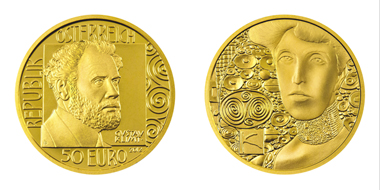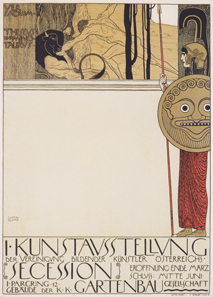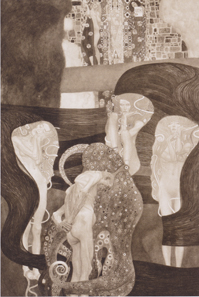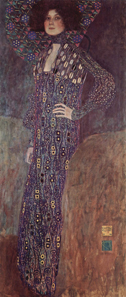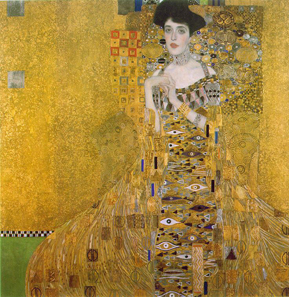January 26, 2012 – The Austrian Mint will issue on 25 January 2012 the first gold coin of a new 5 part gold coin series celebrating one of the leading luminaries of the art nouveau movement, Gustav Klimt, and his primary subject, women. The series commencing this year also marks the 150th anniversary of Klimt’s birth.
The obverse of the coin bears a portrait of Klimt based on a photograph by Moriz Naehr from about 1917 / 1918, framed in a square, that brings to mind the canvas of a painting. The use of the square is also to highlight one of the most common shapes repeatedly used by Klimt in his paintings. In the bottom right corner of the square is Gustav Klimt’s signature based on his signature that he used on his many paintings. To the right of the square is a spiral, much like Klimt used, to ornament the coin. Also on this side appears the country of issue, “Republik Oesterreich” or Republic of Austria, and the face value of 50 euros and year of issue, 2012. The Mint’s chief engraver, Thomas Pesendorfer, engraved the obverse.
The reverse shows a portion of the famous painting of Adele Bloch-Bauer I. The many complex mosaic-like details surround her somewhat sad but serene face. Her beautiful long neck is highlighted with the lovely elaborate choker encircling it. In the bottom left of the design field is the letter “K”, the first letter of Klimt’s last name. Mint engraver Herbert Waehner completed the engraving of the reverse. Mr. Waehner found the engraving of this side both easy and difficult at the same time. “One of the key elements of painting is color, and of course this is not present in this coin. Therefore, the very detailed engraving of the miniscule differences in relief heights of the complex mosaic-like ornamentation in the plaster model was very challenging.”
Klimt was born in Austria in 1862 and very early on his artistic gift became evident. He was classically trained, and began his career by painting murals and ceilings in large public buildings. His great love and primary subject, however, was the female form.
Gustav Klimt, Exhibition poster of the Vienna Secession’s first exhibition (censored version), 1898. Wien Museum. Source: Wikipedia.
Gustav Klimt was one of the founding members of the Vienna Secession, “Ver Sacrum”, art movement that officially existed from 1897-1905 – a movement funded by the government that presented young non-conventional artists. Many very well known artists were also members of this group such as Otto Wagner, Koloman Moser, Josef Hoffmann and Egon Schiele, to name but a few.
Gustav Klimt, Jurisprudence, 1903-1907. Oil on canvas (now destroyed). Source: Wikipedia.
The last public commission completed by Klimt was for three murals for the University of Vienna, featuring Philosophy, Medicine and Jurisprudence. Done in very much his radical style of thought-provoking eroticism, these paintings, when revealed to the public, generated an outcry that was exceptionally strong. With many people having labelled them “pornographic”, these paintings were never used for their original intent in the Great Hall of the University. Sadly, they were destroyed at the end of the Second World War.
Gustav Klimt, Emilie Floege, 1902. Oil on canvas. Historisches Museum der Stadt Wien. Source: Wikipedia.
Klimt tended to work from his home, enjoying a relaxed lifestyle wearing robes and sandals, devoted to his art and life style. His life companion was Emilie Floege whom he met in 1890. Klimt’s love of the female form was not exclusive to his art but to the many relationships he enjoyed. He is known to have fathered 14 children. He died in 1918, at the age of 56, from a heart attack.
From about 1885 onward Klimt enjoyed his “Golden Phase”, reflecting his critical success and acclaim, as well as his regular use of gold leaf in his paintings. His fame brought many patrons to him and he was able to be selective about the commissions he accepted. Klimt received the Golden Order of Merit from Emperor Francis Josef I in 1888, for the murals he painted in the Palace Theatre. Klimt’s painting entitled “Philosophy” won gold at the Paris Exhibitions of 1900, and “Death and Life” received first prize at the world exhibition in Rome in 1915. Several of Klimt’s paintings have brought some of the highest prices ever paid for art in the world.
Gustav Klimt, Adele Bloch-Bauer I, 1907. Oil, silver and gold on canvas. New Gallery, New York. Source: Wikipedia.
The first coin of the series features one of the paintings from this very successful period. It features a painting of Adele Bloch-Bauer. Adele’s husband, Ferdinand Bloch-Bauer, a wealthy industrialist and great supporter of Klimt, commissioned the painting. Ferdinand’s wife was the only woman Klimt painted twice. Thus, this painting is known as Adele Bloch-Bauer I. Adele married Ferdinand at a young age. The couple remained childless; sadly three pregnancies resulted in either stillbirths or the death of the child soon after birth. Adele was a strong and independent lady who was also a somewhat quiet and dark person who socialized in intellectual circles and eventually met Klimt. She was only 26 the first time that Klimt painted her. The many rumours about their relationship and whether or not it was romantic have never been confirmed or denied. Adele died at the age of 43, and her niece Maria Altmann claims she never saw her laugh but rather that she was always very serious.
The painting of Adele is less risqué than many of his others. Klimt painted the first portrait of Adele in a regal pose with a sad look and luscious red lips. The oil painting also features some of his other trade marks using a lot of gold and silver leaf and the multitude of complex painted mosaics that when viewed together become the body of Adele and her lovely flowing robe. The painting took four years to complete.
The ownership of Adele Bloch-Bauer I was for some time hotly disputed and much wrangling occurred to establish clear title to it. The sole surviving heir, Maria Altmann of Los Angeles, claimed it for many years and finally won ownership of this painting as well as four others by Klimt that were once owned by Bloch-Bauer. Once the courts awarded ownership of the paintings to her – she simply sold all of them for huge sums of money. The painting of Adele Bloch-Bauer I was bought by Ronald Lauder, owner of the Neue Galerie in New York, for a reported $135 million in 2006. This painting is a key cornerstone of the Galerie’s collection. The wish of the childless Bloch-Bauer’s that these paintings should be available to all in public galleries was sadly therefore not possible.
The other coins of the series will continue to illustrate the important women in this art nouveau artist’s life. The coins will present his work in a manner similar to an exhibition. As well, each of the coins will have another letter of his name K-L-I-M-T worked into the design – so that once the series is complete his last name will become part of the signature of the 5 coin series.
The new coin is struck in 986 fine gold to a maximum mintage of 30,000 pieces in proof quality only. The diameter of the coin is 22mm and it contains 10 grams of fine gold. Each coin is packed in an attractive box with a numbered certificate of authenticity, which is six pages in length and provides detailed background and technical information about the quality and design of the coin.
A beautiful wooden collection case for the whole series, “Klimt and his Women”, may be purchased separately. It contains a booklet explaining the whole series.
The next four coins of the series are: 2013: Expectation from Stoclet Frieze; 2014: Judith II; 2015: Hygieia from the faculty painting Medicine; 2016: The Kiss.
For more information on this coin set visit the website of the Austrian Mint.
Until now you can visit Klimt’s studio in Vienna which is managed by the Klimt Memorial Society. You may like to take a look on it here.
Many information on Klimt and his whole oeuvre are available to view in the Klimt Online Museum.




